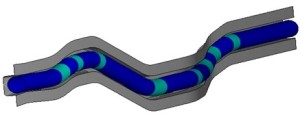Introduction to Hydroforming:
Hydroforming is a metal fabricating and forming process which allows the shaping of metals such as steel, stainless steel, copper, aluminum, and brass. This process is a cost-effective and specialized type of die molding that utilizes highly pressurized fluid to form metal.

In tube hydroforming (THF) there are two major practices: high pressure and low pressure. With the high pressure process the tube is fully enclosed in a die prior to pressurization of the tube. In low pressure the tube is slightly pressurized to a fixed volume during the closing of the die (this used to be called the Variform process).
Today it is mostly used in the automotive sector, where many industrial applications can be found. It is also a method of choice for several tubular members of bicycles.
THF is a method in which tubes are formed by placing a tube between a pair of metal dies and applying hydraulic pressure to inside of tube. In order to prevent wall thinning of tube, it is forced towards and into the dies from both its ends (called axial feeding). Internal pressure and tube end feeding are two important parameters in hydroforming process. The quality of hydroforming depends largely on these parameters and their interactions. Non-optimized choice of these parameters can lead to unacceptable wall thinning (even tube bursting) or wrinkles in final part.
Tube hydroforming has attracted increased attention in automobile industry recently because the automobile designers continue to look for better solutions to reduce weight and cost of vehicle.
The problem??
The proposed hydroforming component to be developed was of a high dual phase high strength steel DP 340/590. It replaced a long member which was produced by conventional stamping and welding of ‘C’ sections made out of conventional carbon steels.


Model description and analysis details:
Single piece/member is not a feasible option for the hydro forming, based on large capital cost involved and due to large tonnage required to form 4mt single piece component, as compared to multi piece options. For multi piece, selecting the joining location is a challenge. Based on the perimeter expansion analysis, four piece options has been decided as discussed in the figure below, the locations were chosen based on bracket location.
Execution and Exploaration:
During the entire exercise of the hydro forming, lot of things were explored.
- We were able to understand how important it is to choose the location in order to optimize the weight of the component.
- During hydro forming simulation, it was observed that friction (lubrication) plays a significant role in hydro forming.
- Larger the friction co-efficient, thinning of the material was observed.
- In the same way, study was done to understand the effect of hardening parameter, it was clearly indicative that, higher the hardening co-efficient, lesser is the thinning.
- The major exploration was, the effect of loading path (Pressure time and Axial feed time curve). Since pressure sequencing depends on tube diameter, thickness, material ultimate strength and minimum radius of the die, any one parameter will alter the loading path of hydro forming.

Conclusion:
With hydroforming approach, the overall weight saving of the component is 11.4% without any design changes to the component. Weight reduction could have further been improved if some design changes are allowed.



